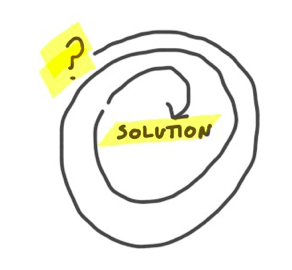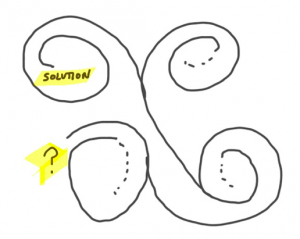I wrote this quite a long time ago and recently came across it again. Such is the beauty of blogging. As I am currently in the process of looking for my next teaching adventure I thought it was worth re-posting to remind myself of my MYP Design roots.
I teach IB MYP Design. I am also in the process of turning my classroom into a sort of Maker Space and I am fascinated by the Tinkering Mindset (so much so that I ran a pro-d session on it last year). Up until recently I have been thinking about these two things separately, but as a result of a recent #MAELM discussion forum I have been wondering how they complement each other. In particular, I have been contemplating a framework that involves these two components, that could be used to help guide students to be more proficient designers and tinkerers.
I use the IB MYP Design Cycle in my classroom.

I think it is the greatest thing since sliced bread. The Inquiring and Analysing stage requires students to think about why they are solving the problem, what they need to know, and what they plan to make. The Developing Ideas stage involves creating criteria that can be used to judge the success of their creation and brainstorming numerous design ideas before selecting and refining one of them. The Creating the solution stage includes creating and following a detailed plan and making thoughtful changes to the plan. Finally the Evaluating stage is based on testing and comparing the data collected to the criteria for success mentioned earlier. It can be a bit onerous for students, but all in all, it is a very successful way to create something worthwhile. I think the design cycle is a great way to approach a problem that you can define and imagine. To me the process is one of zeroing in on the best solution.
Tinkering is also a way to create something worthwhile, but it works differently. A few quotes from the great Tinkering resource Invent to Learn:
Tinkering is a mindset – a playful way to approach and solve problems through direct experience, experimentation, and discovery.
Tinkering encourages making connections, whereas school tends to favor “clean” disconnected problems with clear, unambiguous step-by-step solutions.
I think tinkering is a great way to approach problems that you can’t define or aren’t really sure about yet. In A Simpler Way, Margaret Wheatley states that “playful tinkering requires consciousness…. playful enterprises are alert. They are open to information, always seeking more, yearning for surprises.” I see the process as one of zeroing in on multiple possibilities and then veering off on tangents based on information gleaned from previous explorations.
I have used both these approaches in my classrooms and am an advocate for both, but have also encountered my share of frustrations.
My biggest challenge with the Design Cycle is its perceived linear nature. If you look at the diagram the arrows go both directions, but often in getting students to re-do something or go “back to the drawing board” is so different than the rest of students’ school experiences, it is very difficult to achieve. The result is solutions that are functional, but most often don’t really reflect creativity and out of the box thinking.
Tinkering has creativity and out of the box thinking in spades, but lacks focus and can be a difficult mindset to promote if a student is not already somewhat geared to tinker.
So I started thinking how these 2 approaches to creating can complement each other. In my thinking the relationship will depend on the kind of problem being tackled. If the problem can be defined, then the Design Cycle is the main framework used, but the Tinkering Mindset is applied during the Inquiry and Analysis and Developing Ideas stages. I see this as letting the students do more than internet research. They need to develop prototypes and mess about with the materials they will be using to learn how they work. I see it looking like this:
If the problem can’t be defined, then the Tinkering mindset can be the main approach, but I wonder whether the Design Cycle can’t be applied informally to guide the thinking a little. As a teacher I could then guide my students with questions like: A) What do you need to know? What do you want to make; B) What is important for your creation to be a success? What ideas do you have for making it? C) Did it work? What new ideas do you have? In a sense leading them through a series of mini design cycles while they tinker. To me it looks a bit like this (apologies for the drawing):
Having come to the end of this train of thought I can’t shake the idea that I have just described what everyone else knew all along. But that’s ok, because I only truly get it when I figure it out myself. Still, I think there is value in identifying whether a problem you are trying to address is clear and identifiable or vague and nebulous, as each will require a different approach – either the Design Cycle or Tinkering.





Phil, I really like your thinking on connecting these two ideas. I started a Maker Club at my school this year and have noticed the same difficulties in fostering both these approaches with students as you’ve noted. Students struggle with the iterative nature of complex problem solving inherent to Design approaches and many students need more direction then the open model of tinkering.
I think you hit the nail on the head when you noted:
“In my thinking the relationship will depend on the kind of problem being tackled. If the problem can be defined, then the Design Cycle is the main framework used, but the Tinkering Mindset is applied during the Inquiry and Analysis and Developing Ideas stages.”
This is how I generally think of it as well. However, I’d pose another way of viewing tinkering. Tinkering is not actually a problem solving or design process, but a learning process. The goal of tinkering is increasing fluency with using the tools and resources available that may be used to solve problems in another context and a way of solidifying connections between ideas related to working a particular domain or between domains of skills or knowledge. Tinkering may lead to a solution to a previously identified problem, but the end product isn’t the goal where as the design approach is clearly focused on a solution or end product. By this definition, tinkering certainly still fits as a part of the Identification and Analysis phases.
Perhaps more benefit can be derived for students from Tinkering when they have the kind of structure/support to guide their exploration that you mention at the end of the post. I’m interested in what a more formal model of this might look like and what would make it effective.
Hi Blair,
Apologies for replying so late. It has been a long time since I have had any blog comments. I had to re-read my post before I could put your comments in context. I like the idea of tinkering as a learning process, rather than a problem solving process. Thanks for sharing your thoughts.